#oscar? butch icon i love her so much
Text

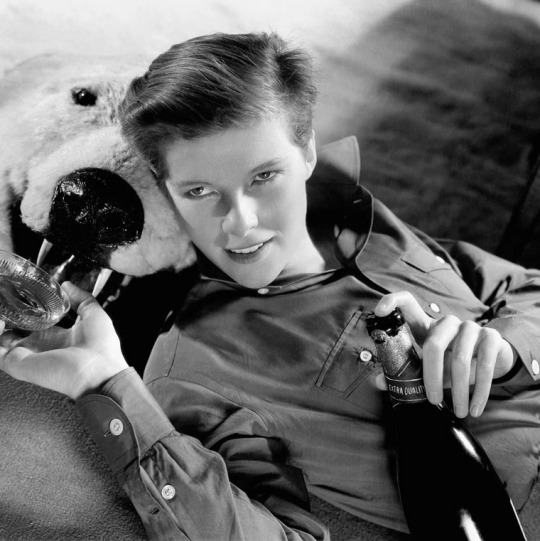
Propaganda
Natalie Wood (West Side Story, The Great Race)—She went through so much shit which I know can be said for all these women but Natalie really was a star and her death often overshadows her career and life. She could make you cry, but she also had the capacity to be incredibly funny which I think is lost on people.
Katharine Hepburn (Bringing Up Baby, The Philadelphia Story, The African Queen)—(I hope someone else submits real propaganda but just in case they don't:) Cries. Screams. Wails. The woman who singlehandedly made me realize I was bi. A real "do i want to look like her. be her. or be with her.' crisis, where the answer was all three. Holy shit please all three.
This is round 5 of the tournament. All other polls in this bracket can be found here. Please reblog with further support of your beloved hot sexy vintage woman.
[additional propaganda submitted under the cut.]
Natalie Wood:
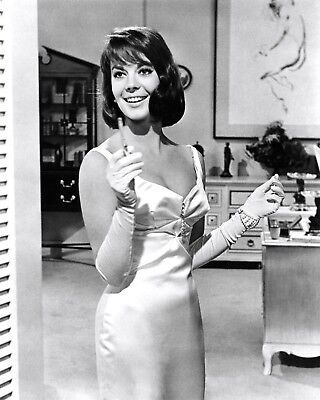
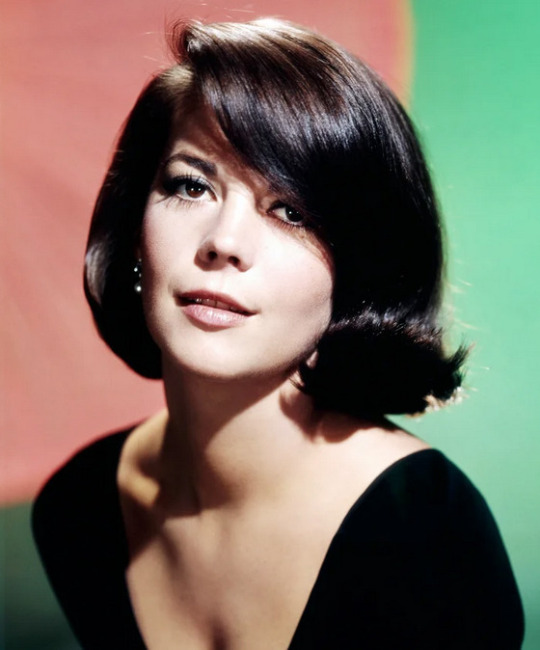
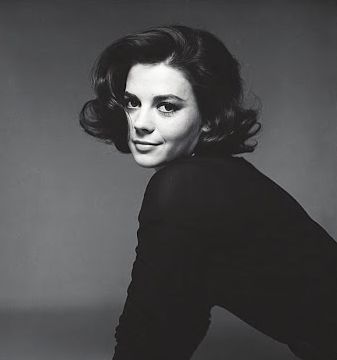
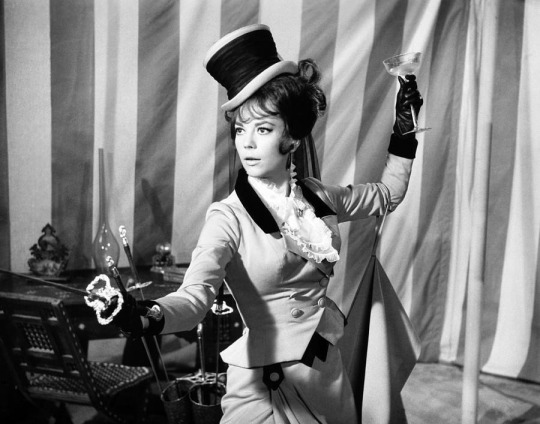
Katharine Hepburn propaganda:
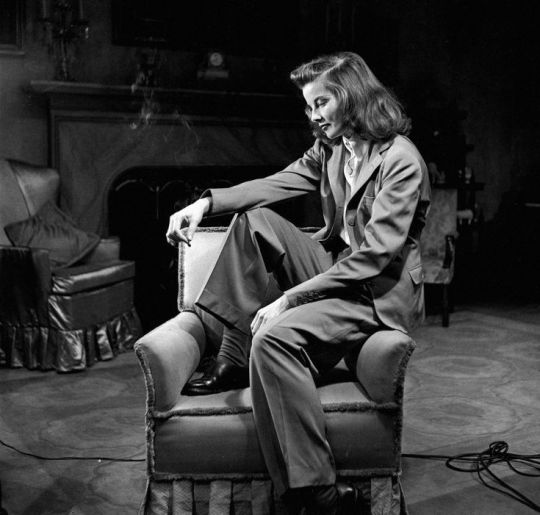
I'm sure one million people will submit her as an iconic Hollywood star but that iconicness might lead people to forget just how insanely hot she was like she had it ALL she was skilled she was funny she was smart she was beautiful AND she was likely bisexual

The single word I would use to explain Katherine Hepburn's appeal is *range*. In her acting career, that meant covering all the ground between lush period dramas and the comedies she did with Carey Grant and Spencer Tracey. In terms of hotness, it meant an uncanny ability to bring anything from a Dietrich-esque androgyny to some of the best Classic Hollywood Glamour you will ever see.
Katharine hep was so cool. The VIBES, the INDEPENDENCE,,, living life on her own terms.

she just had this.... bearing to her, this power. she could be funny, even silly (like in bringing up baby) but also so regal and elegant. she was nobody's fool and dear GOD that's so hot
Fancam link

She’s not only stunningly gorgeous (those eyes that pierce your soul! a jawline you could cut glass with!) but her delivery and physical presence in roles gives off confidence and authority in such a sexy way (truly the biggest dick energy of Old Hollywood). Her fiery energy in The Philadelphia Story? Unmatched.
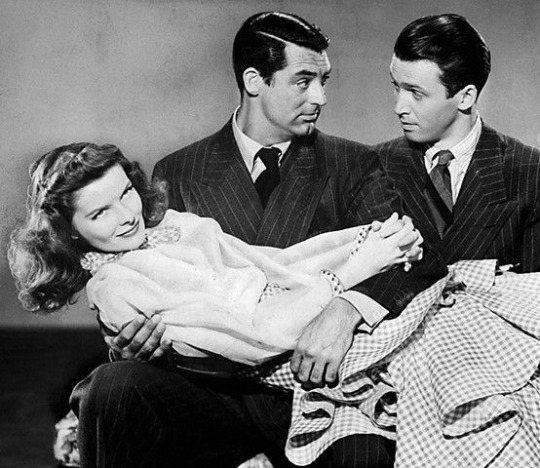
God she's. She's so hot y'all. She has the range!!!!! Funny and dramatic and lovely

She IS the transatlantic accent. Classically gorgeous and such a strong personality.
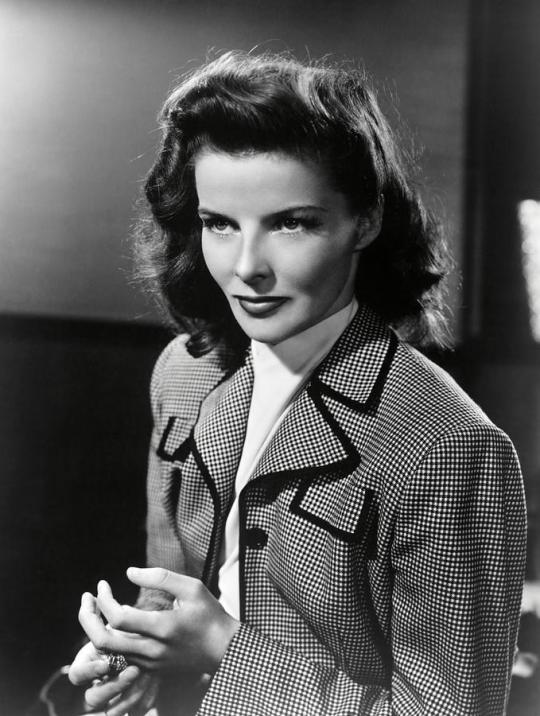
She's literally one of the funniest women to ever live! She goes shot for shot with Cary Grant in Philadelphia Story and we damn well love her for it! She's the most annoying creature to ever live in Bringing Up Baby but she's so insane and funny that we simply cannot help but fall in love with her (and root for her to give Grant an aneurysm!)
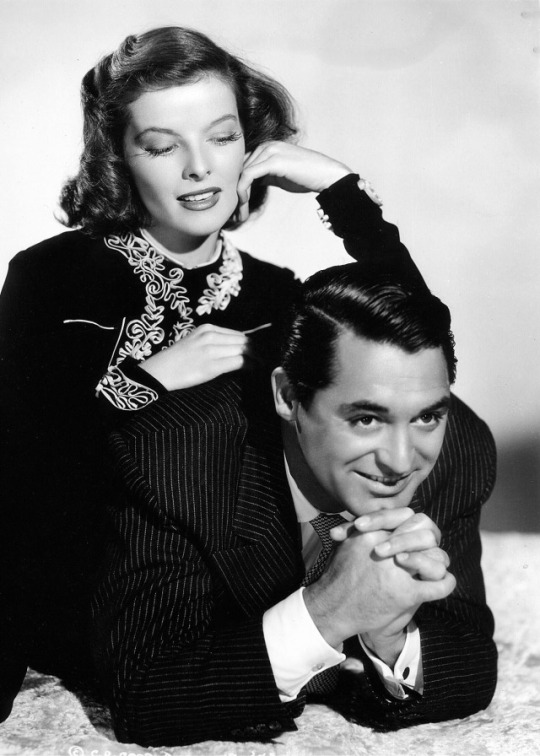
i know she's accounted for but i really want to be sure someone has submitted the scene in bringing up baby where she's pretending to be a gangster
youtube
She simply stuns onscreen; you cannot do anything but be captivated by her presence. Also a non-gender-conforming icon and mild tumblr celebrity by virtue of that one picture from The Warrior's Husband (stage play).
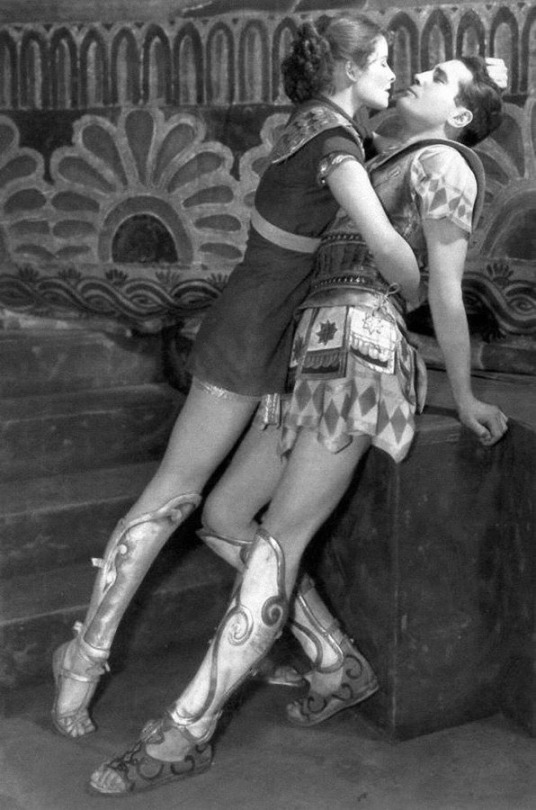
Katharine Hepburn was out here casually changing the lives of young butch lesbians with her gender swag! She wore pants even when people said she shouldn’t, she refused to marry or have kids, and she wore menswear in at LEAST one movie!

If I start thinking about her face for too long I will cry she is so so hot. Katherine is so charismatic and charming in everything she appears in - watch her adopt a leopard and fall in love with her. Also she has the biggest dick energy ever (she and her pal Lauren Bacall share that accolade). Also had an incredibly long and varied career from screw ball comedies to serious dramas - she’s a queen of the screen and I adore her.
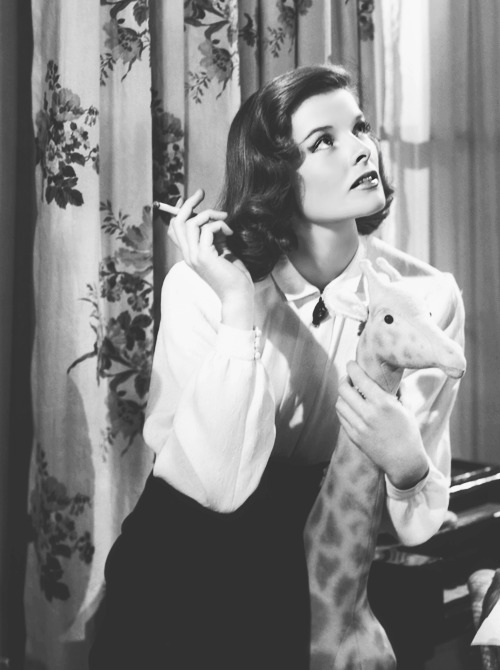
Someone's got to mention it, but she's won the most Oscars out of any performer and is largely considered one of the greatest actresses ever. She's got an incredible voice, an incredible presence, and she absolutely steals every scene she's in. She was private person and deemed standoffish and unapproachable, but she was also profoundly concerned for people's rights and was an outspoken supporter of abortion access. Finally, the Katharine Hepburn slacks look is just iconic. I mean look at her.

This woman. I have been obsessed with her for years. I know the urban legend is a popular one at this point of her walking around set in her underwear when her pants were stolen and she was left with only a skirt, but the pants thing is honestly enough for her to be the hottest in the room in my book. She refused to wear anything else at a time when the public in general and especially the studios did not like that. She was independent, stubborn, and so so very capable. Competency kink anyone? Also, if you want one final way that Katharine's entire life was saying "fuck you" to the establishment, it started young! Her mother took her to suffrage events, and she never got rid of that attitude of justice. I feel like I have barely scratched the surface of all the ways she was such a badass that I'm turning into a rambling mess instead.
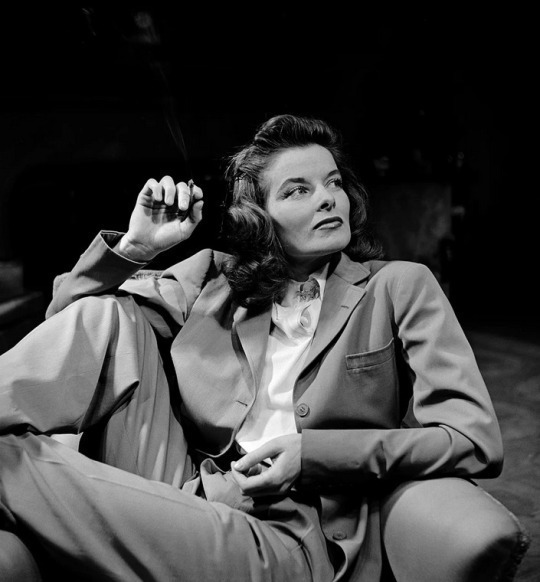
350 notes
·
View notes
Text
hi so naturally i want to talk about the met gala cuz there are amazing things to be said about this and i wanna analyse some aspects of it because my blog and not yours. we saw a lot of avant-garde outfits on the runway as well as some more toned down ones. we saw a lot of people simply copy KL's style by dressing up as him or calling a black slip or suit with sharp white lining an adequate decision. it isn't. so i don't know who most of these people are, i just wanna talk about the looks because im passionate about it.
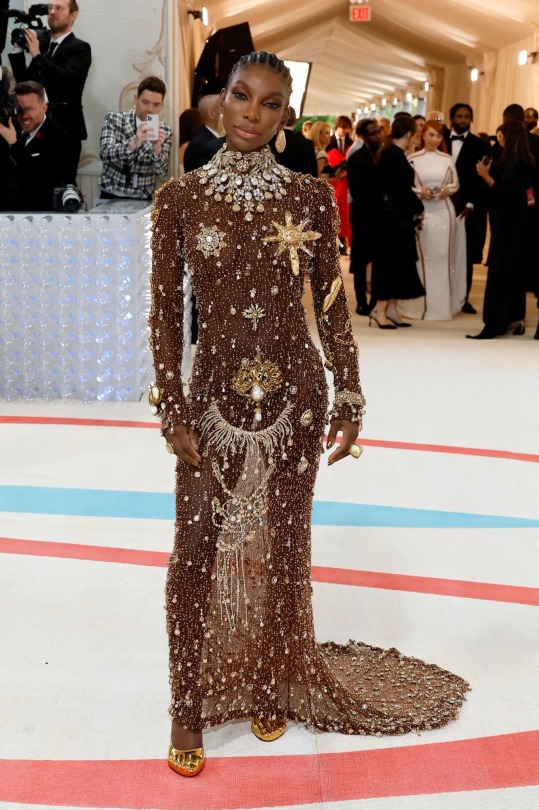

so these are some of my favourites, if not my favourites altogether. both of these people are wearing schiaparelli, a fashion house i am more than pleased to see revived and on runaways now. surrealist as always in style, true to the creator of the house but still modern and shocking, these two fits are to die for. the one to the right is a nude body suit which drips stylishly and methodically in pearls --- seemingly astray with no direction but when you spend more time examining the outfit you see that there are specific motifs to KL's love of pearls and jewels -- a reverse, upside down version of the neck piece near the crotch and thoughtful placement of gems. to the left is a klaus nomi-esque facial structure and look with a front-facing, toned down monochromatic fan which reminds me of the iconic mugler shell dress. [see below] this fan also has subtle vinyl décor which are nods to KL's recurring accessories. style.
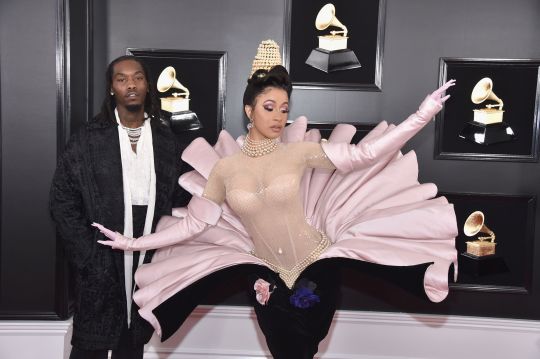
[mugler dress worn by cardi b, corresponding to left image]

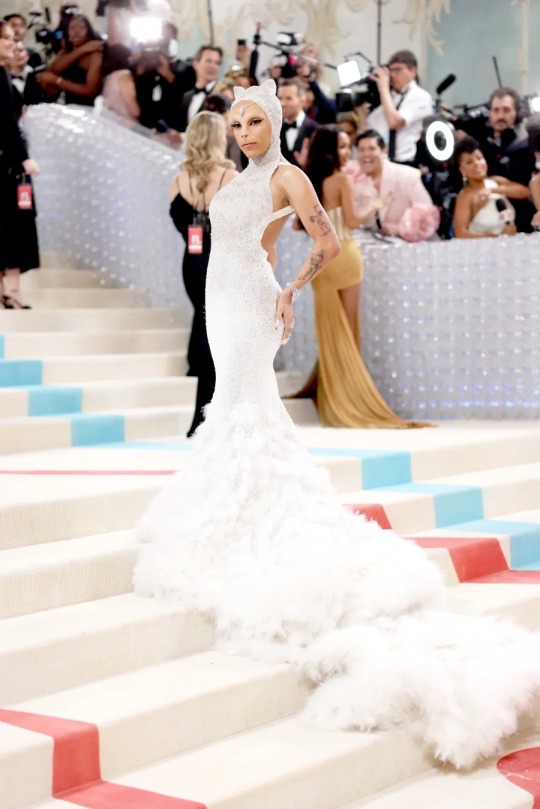
we saw two white gowns with different forms of exaggeration, rihanna adorning a crowded hood of sorts with the white flowers so often seen in KL's designs. here with her husband, asap rocky, who pays tribute in his suit n tie which KL wore like a uniform as well as beaded jeans. their both wearing sunglasses can be interpreted as another motif. rocky has become more adventerous with his style when it comes to not just the met gala but to his day-to-day as well. truly the dream couple. the eyelashes on top of riri's sunglasses is an amazingly camp concept which adds the cherry on top. doja cat wore a nod to choupette, KL's cat which he carried around with him and whatnot but she did it in a much better was than he-who-shall-not-be-named did [he wore a fucking fursuit.] doja wore a oscar de la renta gown with prosthetic cat features and that flowing gown mimicking the fur of choupette. its very charming, with a little bit of a splash of camp, and i loved it. i wanna hug her.
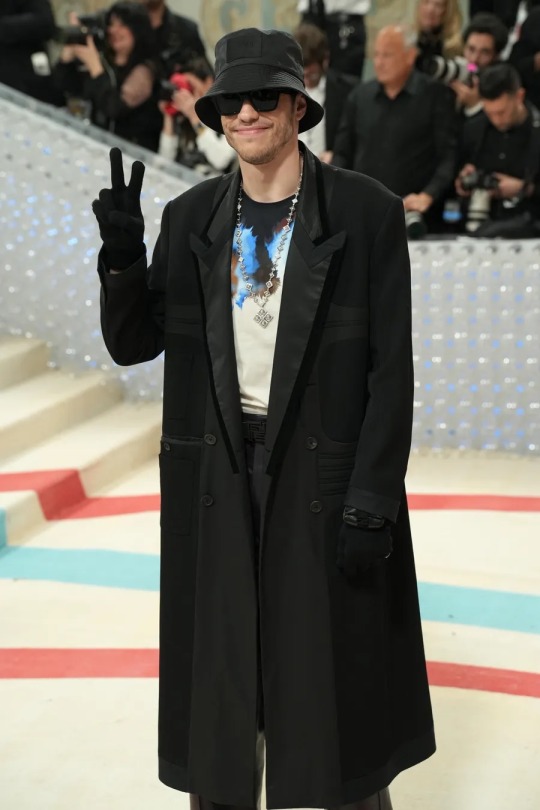

say whatever the fuck you want. say whatever the fuck you want. call me dick hungry. a faggot, a dyke, a freak, a leper. whatever you want. they're so fucking hot. i love pete davidson's long trench coat with that dumb patented bucket hat??? his stupid fucking smile and gloves and peace? maybe im just down bad. he didn't understand the assignment whatsoever. k stew bringing butch realness with a more loose, inverted approach to KL's typical attire. white with black, these wide legged pants with a snatched waist of sorts.... she is so hot stfu.
1 note
·
View note
Photo

draws obscure 70s anime art
#lady oscar#the rose of versailles#wip#doodles#oscar? butch icon i love her so much#im how literally every woman in the show falls for her#thats a big fucken mood#i alrdy know the ending but listen you cant stop me#gotta finish lady oscar n then move onto utena#found out a lot of it was inspired from lady oscar which is neat i love that
25 notes
·
View notes
Text
Pulp Fiction (1994); AFI #94
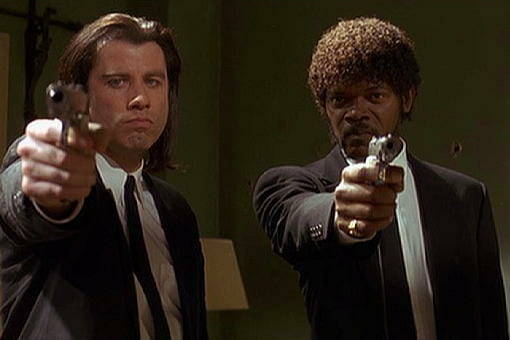
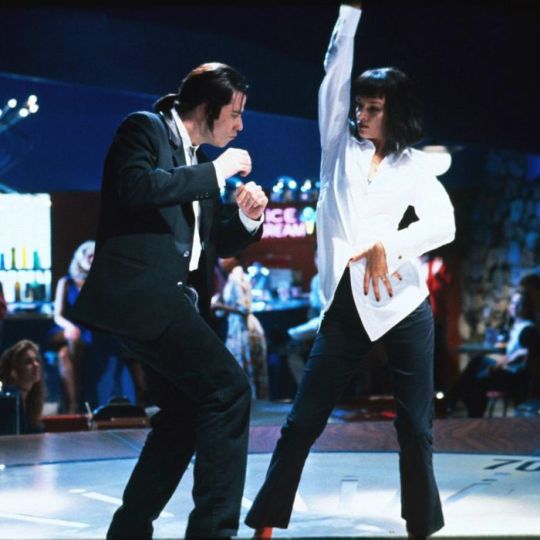




The most recent movie for review was the Quentin Tarantino crime thriller comedy (probably more things) Pulp Fiction (1994). It is a very complicated story that is told out of chronological order and focuses on scenes of meaningful character interaction. This confusion meant it lost out to movies with a more straight forward time line at the Oscars, since the move was nominated for seven awards but only took home one. The single win for best screenplay was well deserved and I still believe it is one of the most creatively written films of all time. I want to go over the plot to show what I mean, but let me do my standard due diligence:
SPOILER WARNING!!! I AM ABOUT TO GIVE THE BASIC DETAILS OF ONE OF THE MOST COMPLEX STORY LINES IN MOVIE HISTORY!!! IT WILL NOT LIKELY SPOIL MUCH OF ANYTHING, BUT I AM STICKING THIS WARNING ON JUST IN CASE SOMEBODY FINDS SOMETHING!!!
-------------------------------------------------------------------------
The film begins with what is pretty much a prologue but what turns out to be about the middle of the film chronologically. A couple is at a diner and they are talking about robbing banks. They only refer to each other as Pumpkin (Tim Roth) and Honey Bunny (Amanda Plummer). They discuss the best kind of places to rob and they decide that a diner would be a good change of pace. Impulsively, they pull out guns and hold up the diner and...title card with awesome spaghetti western music!
Two hitmen are talking about Europe as they go to do a job. Vincent Vega (Jon Travolta) talks about his adventures with Jules Winnfield (Samuel L. Jackson) as they pull up at an Los Angeles apartment complex. The two discuss their boss Marsellus Wallace and how touchy he is about his wife. The boss has apparently sent them to get something from a bunch of guys. Jules and Vincent call on an apartment with 3 college age men and intimidate them into giving over a briefcase with something glowing inside. The case is what they came for, so the hitmen take it and kill two of the men at the apartment...
Flash to a new scene in which Vincent is going to get some drugs from his dealer (Eric Stoltz). Vincent is a heroine user despite cocaine being the popular drug. It turns out Vincent was asked by his boss to take out his wife...the one he is very protective of. He just needs to hang out with her so she is not bored and not get into trouble. To accomplish this, he shoots up some heroine and goes to meet the wife named Mia Wallace (Uma Thurman). They seem to get along and he drives her to a restaurant called Jack Rabbit Slims. The place is fantastic, all the waiters are dressed up like American movie icons and the booths are repurposed cars from the 50s (if this place actually existed, you can be sure I would search it out and go there at least once). The two bond over dinner and then volunteer for a twist dance contest.
Mia and Vincent go back to her house and Vincent goes to the restroom to talk himself out of trying to score with Mia. She is pretty cool, but not worth dying for. While he is away, Mia finds some heroine in the pocket of Vincent’s jacket and thinks it is cocaine. She snorts it and immediately starts to overdose. Vincent panics and decides to drive her to the dealer’s house. The dealer has a nurse kit that comes with a giant needle full of adrenaline which Vincent stabs her with. She wakes up and Vincent takes her back home and is glad that he will live another day...
We jump to a flashback of a young boy who is has lost his father in Vietnam. An officer is visiting that has a gift. Apparently, there is a family watch that belonged to the boys great grandfather and had been passed down through the generations. His father had it when he was captured and gave it to the officer before the father died in the POW camp. The officer escaped and found the boy to give him the watch...
A boxer named Butch (Bruce Willis) wakes up from a dream. He is the boy all grown up. He is about to throw a fight for Marsellus Wallace (Ving Rhames), the same boss that everyone is afraid of. Butch does not throw the fight and accidently kills the other boxer. It turns out that he bet on himself and now he needs to get out of town before Marsellus Wallace catches him. He goes to a hotel where his rather dumb girlfriend is waiting for him. They go to bed and then are about to leave the next morning when it turns out that she forgot his watch. Butch freaks out and goes back to their old apartment to get the watch (note the very long take following Bruce Willis as he takes a back way to get to the apartment). Vincent is there waiting for him, but Vincent is in the bathroom and Butch is able to get a gun and kill Vincent as he is coming out of the bathroom. Things seem good so Butch drives off...
As Butch drives home, he sees Marsellus crossing the street in front of him so Butch hits the gas and runs down the boss but also hits an oncoming car. Both men are injured but Marsellus gains his senses and chases Butch into a shop where both are captured by a weird redneck with a shotgun. Butch and Marsellus are tied up in the basement of the shop and a man named Zed shows up. The shop owner has a gimp in a box (all leathered up and everything) and other fetish things downstairs. After a quick game to pick who goes first, they take Marcellus into another room to rape him. Butch manages to escape and is running away...but he decides can’t leave somebody to be assaulted like that. He grabs a weapon from the shop and kills the shop owner and frees Marsellus from Zed. Marsellus is not happy and says he will go “medieval” on Zed and allows Butch to leave town. Butch collects his girlfriend and leaves immediately...
Flash back in time (we know this because Vincent is alive) to right after Vincent and Jules shoot the guys with the case. Another guy in the other room jumps out and unloads six rounds at the two and misses every shot. The hitman kill that man, but Jules is shaken and decides to give up the business. They take a fourth gut with them in the car to go back to see Marsellus. On the drive over, Vincent accidently shoots the passenger while going over a pothole. The inside of the car is absolutely covered in blood and brains, so the two have to find a safe house. They go to the home of Jimmie (Quentin Tarantino) who will help them but says they have to get out in a couple of hours before his wife gets home. They call Marsellus, who sends over a cleaner named Wolf (Harvey Keitel). They are able to get everything cleaned up in time and leave with the car and the body. Jules and Vincent have to change out of their bloody clothes and decide to take a cab out to a diner for some food before seeing Wallace.
The two are at a familiar looking diner discussing whether their survival was a miracle and whether Jules should quit. Vincent goes off to the bathroom and, while he is gone, Pumpkin and Honey Bunny from the beginning declare it a robbery and it is evident that we have circled in time back around to the beginning. The couple hold up the diner, but, when they get to Jules, he takes Pumpkin hostage and devises a plan for everybody to leave. Jules allows the couple to leave alive with all the wallets, then the two hitmen follow quickly behind them before any police can show up.
---------------------------------------------------------------------------
I put a spoiler warning at the top, but there is so much to this film that there is no way you could spoil everything. I find new things to enjoy about this movie each time that I watch it and the watch count has to be at least two dozen times at this point. This film is so rich with allusion and homage to movies of the past that you might never see everything. Tarantino is truly a lover of old films and he worked every reference he could into this film. This is truly like candy for a cinephile.
I have, however, had a love hate relationship with this movie: I love this movie and I hate it when people tell me it is too violent. There was a lot of negative response to the films toxic masculinity, romancing crime culture, incredible amount of swearing, drug use, extreme gun violence, and very adult themes. There is a very famous interview between Quentin Tarantino and Jan Wahl in which she accuses him of using excessive violence and he tells her it is because it is a lot of fun to watch. His stylistically gory violence stems from exploitation films of the past and there is an established audience that enjoys it. He makes his movies for himself and this group of people.
Kind of like the comedy of Eddie Murphy, Richard Pryor, and George Carlin, you have to wade through a sea of swearing to find the comedic banter. The things that Jules and Vincent say to each other are some of the funniest stuff I have ever heard, but you really have to pay attention. Their attempts to express their feelings while maintaining their hard exterior persona is ridiculous. This is probably why many people enjoy the scenes with Vincent and Mia: there is a lot more courtesy which reduces the tirade of cursing.
The violence is very very over the top, but it is no where near the level of gore that Tarantino has become known for over the years. I must admit that he likes his torture scenes and this film is no exception. I would like to note how clever the torture scene with Butch and Marsellus is because they are both tied up and facing camera so only the audience can see the mischief that is being prepared behind them.
The soundtrack for the film is well worth mentioning as it also pays homage to 50s, 60s, and 70s exploitations films. There is a lot of silence in the film with sudden bursts of fast paced music that help with transitions. Most famous is the intro music after diner prologue, a surf rock classic by Dick Dale and The Del Tones called Misirlou. It is pure speed guitar riff along the lines of Wipeout and transitions the scene perfectly. Take a listen for yourself:
https://www.youtube.com/watch?v=ZIU0RMV_II8
Maybe the biggest thing about this film and Tarantino in general is the inspiration of the slick gangster dialogue. There had been a push for more melodramatic dialogue or the complete absence of much talking. Tarantino added in this slick, fast moving comedic dialogue that is said over extreme violence and adult situations. Marsellus Wallace talks about having some crack heads torture a man to death immediately after being raped in a basement. The hitmen talk about appropriate manners while cleaning out brains from the back of a car. Jules talks about the meaning of the bible during a robbery. Everything seems out of place in the real world but perfectly acceptable in Tarantino’s world. This is probably why I have no problem with the violence in the film.
So should this film be on the AFI top 100? Absolutely. It is an homage to film history while simultaneously introducing a sub genre that mixes current dialogue and exploitation touches to grindhouse action. It is fascinating and fun. Would I recommend this movie? If you are old enough. I can’t emphasize enough how fun I find this film, but I cannot deny that it is filled with adult situations like drug usage followed by driving, secret dungeon rape, and cold blooded murder with no consequences. If you can differentiate between Tarantino’s world and the real world, then this is great. If you can’t, then maybe try something else with slick dialogue like Butch Cassidy and the Sundance Kid.
#miserlou#pulp fiction#samuel l jackson#Quentin Tarantino#john travolta#violence#action#90s movies#academy award winner#dialogue#cinematography#introvert#introverts
20 notes
·
View notes
Link
“BUTCH” HAS LONG been the name we’ve given a certain kind — that kind — of lesbian. The old adage applies: You know her when you see her. She wears men’s clothing, short hair, no makeup. Butch is an aesthetic, but it also conveys an attitude and energy. Both a gender and a sexuality, butchness is about the body but also transcends it: “We exist in this realm of masculinity that has nothing to do with cis men — that’s the part only we [butches] know how to talk about,” says the 42-year-old writer, former Olympic swimmer and men’s wear model Casey Legler. “Many people don’t even know how to ask questions about who we are, or about what it means to be us.”
Many of us wear the butch label with a certain self-consciousness, fearing the term doesn’t quite fit — like a new pair of jeans, it’s either too loose or too tight. The graphic novelist Alison Bechdel, 59, doesn’t refer to herself as butch but understands why others do. “It’s a lovely word, ‘butch’: I’ll take it, if you give it to me,” she says. “But I’m afraid I’m not butch enough to really claim it. Because part of being butch is owning it, the whole aura around it.”
What does owning it look like? Decades before genderless fashion became its own style, butches were wearing denim and white tees, leather jackets and work boots, wallet chains and gold necklaces. It isn’t just about what you’re wearing, though, but how: Butchness embodies a certain swagger, a 1950s-inspired “Rebel Without a Cause” confidence. In doing so, these women — and butches who don’t identify as women — created something new and distinct, an identity you could recognize even if you didn’t know what to call it.
By refuting conventionally gendered aesthetics, butchness expands the possibilities for women of all sizes, races, ethnicities and abilities. “I always think of the first butch lesbian I ever saw,” says the 33-year-old actor Roberta Colindrez. “This beautiful butch came into the grocery store and she was built like a brick house. Short hair, polo shirt, cargo pants and that ring of keys … It was the first time I saw the possibility of who I was.” And yet, to many people, “butch style” remains an oxymoron: There’s a prevalent assumption that we’re all fat, frumpy fashion disasters — our baseball caps and baggy pants suggest to others that we don’t care about self-presentation. But it’s not that we’re careless; it’s that unlike, say, the gay white men who have been given all too much credit for influencing contemporary visual culture, we’re simply not out to appease the male gaze. We disregard and reject the confines of a sexualized and commodified femininity.
ETYMOLOGICALLY, “butch” is believed to be an abbreviation of “butcher,” American slang for “tough kid” in the early 20th century and likely inspired by the outlaw Butch Cassidy. By the early 1940s, the word was used as a pejorative to describe “aggressive” or “macho” women, but lesbians reclaimed it almost immediately, using it with pride at 1950s-era bars such as Manhattan’s Pony Stable Inn and Peg’s Place in San Francisco. At these spots, where cocktails cost 10 cents and police raids were a regular occurrence, identifying yourself as either butch or femme was a prerequisite for participating in the scene.
These butches were, in part, inspired by 19th-century cross-dressers — then called male impersonators or transvestites — who presented and lived fully as men in an era when passing was a crucial survival tactic. We can also trace butchness back to the androgynous female artists of early 20th-century Paris, including the writer Gertrude Stein and the painter Romaine Brooks. But it wasn’t until the 1960s and early 1970s that butches, themselves at the intersection of the burgeoning civil, gay and women’s rights movements, became a more visible and viable community.
From their earliest incarnations, butches faced brutal discrimination and oppression, not only from outside their community but also from within. A certain brand of (mostly white) lesbian feminism dominant in the late ’70s and early ’80s marginalized certain sorts of “otherness” — working-class lesbians, lesbians of color and masculine-of-center women. They pilloried butchness as inextricably misogynist and butch-femme relationships as dangerous replications of heteronormative roles. (Such rhetoric has resurfaced, as trans men are regularly accused of being anti-feminist in their desire to become the so-called enemy.) Challenged yet again to defend their existence and further define themselves, butches emerged from this debate emboldened, thriving in the late ’80s and early ’90s as women’s studies programs — and, later, gender and queer studies departments — gained traction on North American and European college campuses.
The ’90s were in fact a transformative decade for the butch community. In 1990, the American philosopher Judith Butler published her groundbreaking “Gender Trouble: Feminism and the Subversion of Identity,” and her theories about gender were soon translated and popularized for the masses. In her academic work, Butler argues that gender and sexuality are both constructed and performative; butch identity, as female masculinity, subverts the notion that masculinity is the natural and exclusive purview of the male body. Soon after, butch imagery infiltrated the culture at large. The August 1993 issue of Vanity Fair featured the straight supermodel Cindy Crawford, in a black maillot, straddling and shaving the butch icon K.D. Lang. That same year, the writer Leslie Feinberg published “Stone Butch Blues,” a now classic novel about butch life in 1970s-era New York. In Manhattan, comedians such as Lea DeLaria and drag kings such as Murray Hill took to the stage; it was also the heyday of Bechdel’s “Dykes to Watch Out For,” the serialized comic strip she started in 1983. In 1997, Ellen DeGeneres, still the most famous of butches, came out. Two years later, Judith “Jack” Halberstam and Del LaGrace Volcano published “The Drag King Book” and the director Kimberly Peirce released her breakthrough film, “Boys Don’t Cry”; its straight cisgender star, Hilary Swank, went on to win an Oscar for her portrayal of Brandon Teena, a role that still incites contentious debates about the nebulous boundaries between butch and trans identity. These artists and their legacies are the cornerstones of our community. As Legler says, “This is where we’ve come from, and the folks we look back to. If you identify with that lineage, then we’d love to have you.”
LIKE ANY QUEER subculture, butchness is vastly different now than it was three decades ago — though the codes have been tweaked and refined over the years, younger butches continue to take them in new and varied directions: They may experiment with their personas from day to day, switching fluidly between masculine and feminine presentation. There are “stone butches,” a label that doesn’t refer to coldness, as is often assumed, but to a desire to touch rather than to be touched — to give rather than receive — and is considered slightly more masculine than “soft butch” on the Futch Scale, a meme born in 2018 that attempted to parse the gradations from “high femme” to “stone butch.” (“Futch,” for “femme/butch,” is square in the middle.) And while there remains some truth to butch stereotypes — give us a plaid flannel shirt any day of the week — that once-static portrait falls apart under scrutiny and reflection. Not every butch has short hair, can change a tire, desires a femme. Some butches are bottoms. Some butches are bi. Some butches are boys.
Different bodies own their butchness differently, but even a singular body might do or be butch differently over time. We move between poles as our feelings about — and language for — ourselves change. “In my early 20s, I identified as a stone butch,” says the 45-year-old writer Roxane Gay. “In adulthood, I’ve come back to butch in terms of how I see myself in the world and in my relationship, so I think of myself as soft butch now.” Peirce, 52, adds that this continuum is as much an internal as an external sliding scale: “I’ve never aspired to a binary,” she says. “From day one, the idea of being a boy or a girl never made sense. The ever-shifting signifiers of neither or both are what create meaning and complexity.”
Indeed, butch fluidity is especially resonant in our era of widespread transphobia. Legler, who uses they/them pronouns, is a “trans-butch identified person — no surgery, no hormones.” Today, the interconnected spectrums of gender and queerness are as vibrant and diverse in language as they are in expression — genderqueer, transmasc, nonbinary, gender-nonconforming. Yet butches have always called themselves and been called by many names: bull dyke, diesel dyke, bulldagger, boi, daddy and so on. Language evolves, “flowing in time and changing constantly as new generations come along and social structures shift,” Bechdel says.
If it’s necessary to think historically, it’s also imperative to think contextually. Compounding the usual homophobia and misogyny, black and brown butches must contend with racist assumptions: “Black women often get read as butch whether they are butch or not,” Gay says. “Black women in general are not seen, so black butchness tends to be doubly invisible. Except for studs: They’re very visible,” she adds, referring to a separate but related term used predominantly by black or Latinx butches (though, unsurprisingly, white butches have appropriated it) who are seen as “harder” in their heightened masculinity and attitude. Gay notes that “people tend to assume if you’re a black butch, you’re a stud and that’s it,” which is ultimately untrue. Still, butch legibility remains a paradox: As the most identifiable of lesbians — femmes often “pass” as straight, whether they want to or not — we are nonetheless maligned and erased for our failure of femininity, our refusal to be the right kind of woman.
ANOTHER LINGERING stereotype, one born from “Stone Butch Blues” and its more coded literary forebears, particularly Radclyffe Hall’s “The Well of Loneliness” (1928), is the butch as a tragic and isolated figure. She is either cast out by a dominant society that does not — will not — ever see her or accept her, or she self-isolates as a protective response to a world that continually and unrelentingly disparages her.
When a butch woman does appear in mainstream culture, it’s usually alongside her other: the femme lesbian. Without the femme and the contrast she underscores, the butch is “inherently uncommodifiable,” Bechdel says, since two butches together is just a step “too queer.” We rarely see butches depicted in or as community, an especially sobering observation given the closure of so many lesbian bars over the past two decades. But when you talk to butches, a more nuanced story emerges, one of deep and abiding camaraderie and connection. Despite the dearth of representation, butch love thrives — in the anonymous, knowing glances across the subway platform when we recognize someone like us, and in the bedroom, too. “Many of my longest friendships are with people who register somewhere on the butch scale,” Peirce says. “We’re like married couples who fell in love with each other as friends.”
Legler, for their part, recognizes a “lone wolf” effect, one in which some young queers initially love “being the only butch in the room.” In organizing the group portrait that accompanies this essay over the past months, Legler was curious “what it would be like for butches to just show up together and to be able to display all of their power, all of their sexiness, all of their charisma, without having it be mitigated in some way.” And not only for butches of an older generation, but for those still figuring things out, transforming the scene in ways that both defy and inspire their elders. “It’s been centuries in the making, the fact that we are all O.K.,” Legler adds. “That our bodies get to exist: We have to celebrate that. You can do more than just survive. You can contribute.”
44 notes
·
View notes
Note
Hi I know it’s been a bit but I’m the confused bi anon. I really really appreciated your response and it wasn’t too long. You made me feel a lot better. I was wondering if you could maybe suggest some books, tv, movies with bi female characters. Thanks soo much for the entire last response . You are absolutely incredible and so sweet. This means more to me than you could ever know❤️
of course!! i’m glad that my first response helped <3
disclaimer of course: i’m not bi! so i’m not an Authoritative Source on bi rep and what people want to see more of. i do actively seek out stuff about lgbtq+ characters, specifically girls and women, so i have some recs! however, i’ll also be adding some things that some bi folks i know have recommended because while lesbians and bi women have a lot in common, these are at the end of the day representing them, not me :)
extra-super favorites will be bolded! i’m putting this under a read more because... i read a lot of books. and recommended a lot of them.
books:
her royal highness by rachel hawkins-- this book is a pretty easy read-- don’t expect any massive revelations about life from it, and you’ll have a good time!!! essentially, a bi texan girl named millie, after having her heart broken by her friend-turned-sort-of-gf, goes to boarding school in scotland and ends up rooming with the princess, flora. if this sounds outrageous and sappy, that’s because it is! and i love it! sexuality isn’t a BIG part of this book, but it’s discussed, and it’s just a generally fun enemies-to-lovers story about a bi aspiring geologist and a no-fucks-to-give lesbian princess and them falling in love!
fried green tomatoes at the whistle stop cafe by fannie flagg-- hello this is actually my favorite book! unlike hrh it is... a LOT to read. it essentially follows 2 stories-- one about a housewife named evelyn and her friendship with an old woman named ninny threadgoode who she meets at the old folks home her mother-in-law stays at, and the other about the stories ninny tells her about her sister-in-law idgie and her partner, ruth. the book was published in 1987, and ruth and idgie’s story is set during the great depression, so they aren’t actively labeled as lesbian or bi, but it’s made obvious enough through coding and the fact that ruth has relationships with men prior to idgie while idgie spends her entire childhood pining after ruth. both storylines are fantastic-- they have a lot to say about the lives of southern women in the 30s and 80s, and about race relations at both periods. i’ll warn you that there are depictions of extreme racism and of abuse, but it handles both delicately. it’s a critical piece of southern literature, and a landmark for lgbtq+ storytelling. as a bonus, my copy has a bunch of great recipes in the back, so if you read it you might chance upon an edition with those in it. if you like poignant period pieces about wlw relationships, women losing their damn minds, and abusive men getting what they deserve, this is the book for you! you will sob. this is a fair warning.
you should see me in a crown by leah johnson-- i haven’t personally read this one, but i’ve heard great things about it from everyone i know who has! an anxious black bi girl in indiana has to win prom queen at her mostly-white school in order to get enough scholarship money to go to the college of her dreams, but ends up falling for mack, another girl running for queen.
@landlessbud wanted me to shout out red, white, and royal blue by casey mcquinston-- you’ve almost definitely heard about it before (first son and prince of wales, enemies-to-lovers with a side dish of political drama), and it is primarily about a mlm romance, but nora is a fabulously fun bi girl side character and there’s a lot of great stuff about figuring out your sexuality in it.
leah on the offbeat by becky albertalli-- i’ve read a lot of complex thoughts on this book, and mine are... i like it! it’s flawed, sure, and i wish it had handled a few things a little better, but you know what? it’s cute as fuck! leah is a fat bi drummer, and she’s super cool! abby is a great love interest, and she goes through a whole bi realization throughout the book. all in all, it’s just a fun wlw high school romcom with a couple solid dramatic beats and a lot of goofball shenanigans. also, if you were an american girl kid??? one scene in this book will make the entire experience worth it for you.
harley quinn: breaking glass by mariko tamaki and steve pugh-- hey, we’re in graphic novel territory now! this book is RAD. a really neat look at gentrification, community solidarity, giving people what they deserve, and fantastic lgbtq+ found families. teenage harleen quinzel is taken in by a group of drag queens, and is caught between two sort-of love interests-- mysterious vigilante the joker and classmate and community activist ivy-- and the different forms of protest and resistance they represent. the art here is STUNNING, and it’s a great read!
laura dean keeps breaking up with me, by the great mariko tamaki with art by rosemary valero-o’connell-- the vast majority of the characters are lgbt, with a lesbian main character, and the supporting cast including a bi nonbinary character, a bi girl character, and two mlm characters! this is mostly a piece about modern lgbtq+ teenagers and the way toxic relationships take over our lives. it’s one of the most cathartic things i’ve read in a LONG time, and especially if you’re at a point where your sexuality feels kind of vague, this is a great read because it embraces that vagueness by not needing to clearly label the characters and celebrates whatever point of clarity the characters are at. probably some of the most gorgeous art i’ve ever seen in a book, with a beautiful black-white-and-pink color scheme and a really neat approach to visual storytelling.
movies:
i don’t watch many movies, because i get bored really quickly hskdhskhds. but the movies i DO watch are usually gay!
wowie zowie its fried green tomatoes again!-- fannie flagg came back to adapt this into a film and HOT DAMN is it just as good. the plot is primarily the same, with some stuff obviously cut or trimmed to make it a two hour movie instead of a 450 page books fhsjdhsjhds. mary-louise parker plays ruth!!! it got a GLAAD award and an oscar nomination, and god it’s good. there are a couple scenes in here that i think are going to be in my mind until the day i die. the level of pure butch energy that idgie radiates in this film is a one-hit k.o. and it KILLS me.
birds of prey-- listen. this is not a profound movie. harley’s bisexuality isn’t emphasized, and romance is basically nonexistent in this movie. there is some... quite graphic violence. that said, this movie is so fucking fun. it’s mostly just a bunch of women fucking up everyone who crosses them while margot robbie gives a gleeful performance that you can just TELL she enjoyed the fuck out of. the last 20-30 minutes of this movie are the absolute best part, with a long sequence that kind of reinvented what an action/superhero movie could be for me. again, bisexuality isn’t a massive part of this-- it’s mentioned, and then harley just continues on in her gloriously campy outfits and breaks peoples’ knees. again, i CANNOT overemphasize just how fucking good the last 20-30 minutes are. this movie knows what it is and it embraces it. also, women beating people up in costumes that don’t horrifyingly objectify them is always a plus!
imagine me & you-- i’d be remiss if i didn’t mention this one, considering it’s probably one of the most iconic wlw romcoms. a woman named rachel, while at her own wedding, meets a florist named luce, and they fall in love. it’s a very sweet look at questioning your sexuality when you were already secure in it, and rachel’s husband wins “most genuinely understanding guy in a wlw movie” award. it has a lovely happy ending, and articles have been written about the importance of rachel being a bi character who a) gets a happy ending and b) isn’t shamed for figuring out her sexuality later on or slutshamed. this is just... a sweet movie. it’s the romcom a lot of us need in our lives. also, a LOT of floral imagery.
tv shows:
ok, i’ve got a confession. i reaaaaaaally don’t watch much tv. seriously, the only shows i’ve watched a substantial amount of recently have been parks and rec, schitt’s creek, the good place, and gilmore girls. i have a really REALLY short attention span.
that said, eleanor from the good place is bisexual!! the good place is a really wild ride, it’s half afterlife comedy half philosophical musing, and it will almost certainly make you gasp, laugh, think, and also probably cry. also, eleanor is just buckets of fun and she, like many of us, is often blown away by tahani (jameela jamil) and her beauty.
ummm shows i haven’t watched entirely or at all but that have bi women in them and seem pretty good: black lightning, sex education, jane the virgin, arrow.
if you haven’t already watched it, do not believe what people are going to tell you about watching glee. it will drag you into a pit of despair and white men rapping, and it’s quite biphobic to top it all off.
i hope you enjoy at least some of these!! i tried to include some of my own favs and some that were pointed out to me, so i hope that at least a couple connect with you and make you feel better. again, the bolded ones are my 100% favorites. i love you and i’m glad you reached out again!!! feel free to send some more asks later on <3
#asks#anon#bi anon#ily <3 <3 i hope these help#if anyone wants to add please do!! specifically bi women of color since theres a shortage of them in fiction and media#dont talk abt b/9/9 though id like to not praise diversity in a show glorifying cops
5 notes
·
View notes
Text
mamma mia! (2008) - part 1

mamma mia! is a musical starring meryl streep and amanda seyfried (post-mean girls but pre-les mis), in which seyfried’s character sophie discovers she has three potential dads and invites all three of them to her wedding on an idyllic greek island. got all that? and the best and DEFINITELY most important aspect? it’s allllll ABBA songs baby. talk about culture clash (1970s sweden vs 2008 greece? actually we’ll come to the 2008 part later). it’s cheesy and raucous and loud and sweet and an utter riot of joy, and the only musical my best friend actually doesn’t hate. and his excuse for hating musicals is that they’re cheesy so i think someone needs to work on their argument.
hi everyone! so love island has finished, i’ve just got back from holiday to torrential rain – thanks england – and meryl streep owns my ass, so before i go and see mamma mia! here we go again a gazillion more times (and meet the director AGHHHHH yes that’s actually happening) i’m gonna review the first one! bear in mind that i’ve seen this film literally 100 million times please. i can’t actually stress how much i adore this film and it’s my comfort film that i watch when I’m sad or ill or tired or bored in history. i’ll pick holes in the technical aspects of it but just know that i would die for this film. got it? lets go.
visually, it’s a pretty film. nothing toooo wild or groundbreaking (like florals for spring) but it’s saturated and dusty and bright and 100% suits the tone and setting of the film. it also has a softness and realness to it that i feel we don’t get anymore from hollywood in 2018 – if a film isn’t crisp and chockablock with cgi and visual effects, then it’s not making bank, and that includes you, new mamma mia. from a glance at this film, you know it’s set in the mediterranean. also the faded and bright quality of the film evoke some of the 70s imagery, not only of ABBA but of donna’s (meryl streep) past.
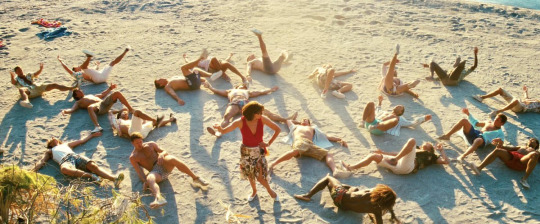
the costumes are also gorgeous and so camp and bright and cheesy! mamma mia! knows what film it is and keeps itself campy and cheesy without skimping on quality, and this is especially prevalent in the disco costumes, particularly super trouper and the end credits (which are oscar worthy in themselves lets be honest)

so I know it was originally a west end musical and having source material makes screenwriting easier, but i love the way the songs are worked in. nothing feels forced and once again, the crew didn’t have to compromise on quality by changing most of the words, which is a relief to the avid ABBA fan. and yes, this is a complaint i’ll revisit in my mamma mia! here we go again review.
why does sophie go post her letters on the mainland at midnight? did she sneak out? didn’t donna or sky question this?
also this will come up again a bit later but why do they have to shoot night scenes during the day and then try to colour correct? It’s just PAINFUL. can’t y’all shoot at night? jesus. also this is my theory as to why they cut the name of the game later in the film with bill and sophie – because it looked like shite!!!

this is EVIDENTLY SHOT DURING THE DAY CAN’T Y’ALL EVEN TRY?! THAT IS FUCKING SUNLIGHT BUT I GUESS MAYBE I’M WRONG AND THAT’S NOT HOW LIGHT WORKS
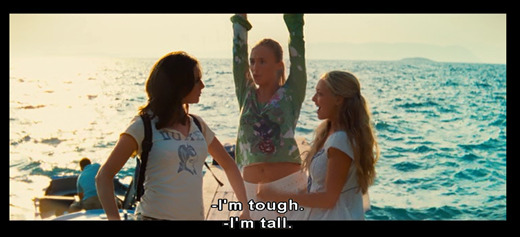
I ALWAYS THOUGHT THE SONG WAS “I’M TALL I’M TALL I’M TINY” BUT I GUESS I’M WRONG also i love that being ‘tough’ is this scottish girl’s quantifier in her friendship group. is that racist? smh mamma mia u ain’t woke
you know what isn’t fucking mentioned once in mamma mia 2? (yes i am already sick of typing out the whole damn name so this is what you get) BILL’S ICONIC EYE TATTOOS. okay butch count olaf i see u sweetie
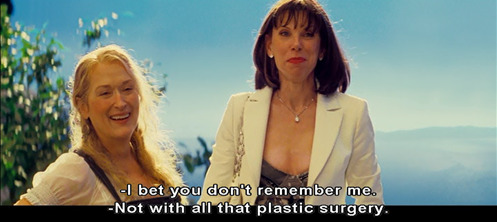
did they hire christine baranski before or after this line was written? because either way that’s…………. savage

this is 1000000% a whole ass reach but is sophie wearing three little stars on her necklace to represent her dads? Because that’s some adorable shit right there

this is still the coolest scene transition ever imo
okay why have they got sophie doing these anime-ass gasps when she sees her dads for the first time lmao
QUESTION: how did sophie meet her two friends? did they stay on the island? this IS a question i’ll be asking director of mamma mia! here we go again ol parker when i see him in two weeks. also WHERE ARE THEY IN THE SECOND MOVIE FFS
and on that note how does sophie know sky?
sooooo this film is supposedly set in 2000? if sophie is born in 1980 according to the second mamma mia film…… so sky is setting up a website for donna in 2000? i did some research trying to trip the film up for not actually being set in 2000 when it was released but i can’t find anything incriminating. just know….. that i know the truth. you can’t hide from me phyllida lloyd.
Is aunt sophia dead?
the guy who hits on tanya does have a name and it is pepper. i was initially wondering why it wasn’t mentioned in the film but now i guess i know why. also it is shouted at him at some point in the second act but i guess i just thought they were….. hurling abuse?? idk
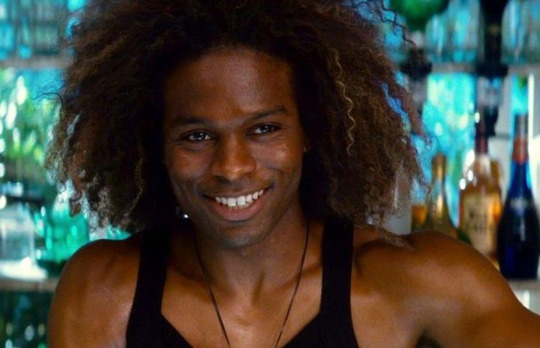
the level of innuendo in this film that completely went over my head as an 8-year-old is unreal
also shoutout to my friend hannah for not realising harry is gay even though he basically says it. and makes out with a dude. and sings take a chance on me to him which is honestly the most convincing part. love you han x
harry’s greek boyfriend is actually called petros or smth but he looks like a fabio so we’re calling him fabio
okay here’s where we’ll leave part 1!! keep ya peepuhs peeled (not ya noggin. god that’s quite the reference) for part 2!!
#mamma mia!#2008#Film Review#amanda seyfried#meryl streep#julie walters#christine baranski#dominic cooper#mamma mia here we go again#abba#films#offtothepictures
8 notes
·
View notes
Text
@sassydelusions tagged me in the top ten character meme! This was really tough y'all but here we go!
1. Lady Oscar (Rose of Versailles)
OG bisexual butch queen, everything I could ever want in a woman, all around hero, beautiful actual rose in human form.
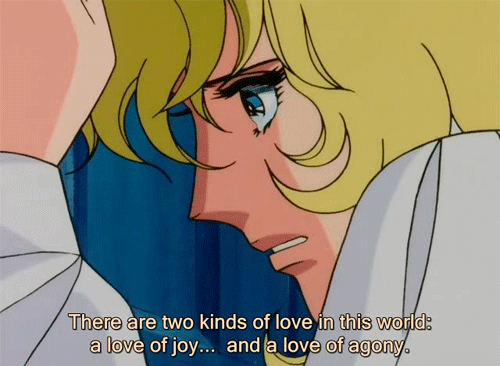
2. Utena Tenjo (Revolutionary Girl Utena)
Lady Oscar 2.0 but this time gayer, pinker, with more revealing clothes. Utena and this show in general played a major role in my sexual awakening at the tender age of eight when omg I realized I was very queer.
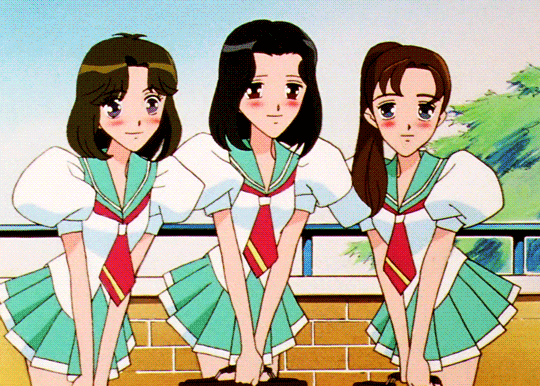
3. Sailor Moon
First anime I ever watched (age 4) and boy it changed my life. I love this character so much, she's endlessly kind and puts her friends above everything and genuinely believes in the good in humanity. She helped shape my character a lot from a moral standpoint. Also, a pansexual icon.
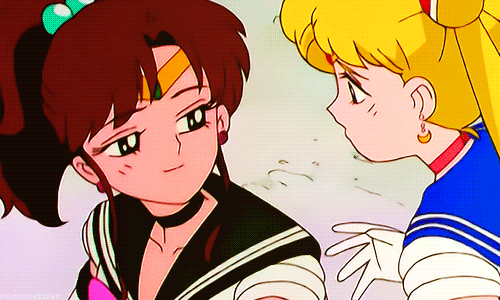
4. Elvira, Mistress of the Dark
A goth barbie doll, Elvira also played a role in me realizing I was gay but also inspired me to be over the top af. I relate to her personality so, so much.

5. Beatrix Kiddo (Kill Bill)
Kill your rapist, then all your ex's friends, then your ex. That'd be about square.
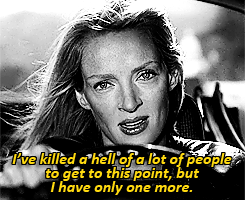
6. Data (Star Trek: TNG)
A sweet android baby. But also daddy af? Makes me feel enough emotions for both of us. Fully functional and anatomically correct.

7. Chirrut Imwe (Rogue One)
I aspire to be the person Chirrut Imwe believes I can be. Also daddy.
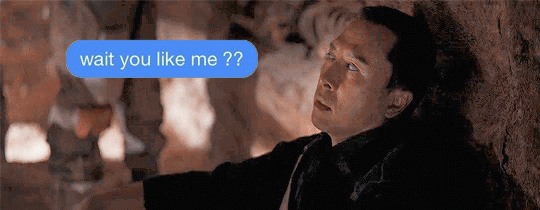
8. Ben Solo (Star Wars)
Did nothing wrong. Amazingly thick. Perfect tits. Very sad. Save him.
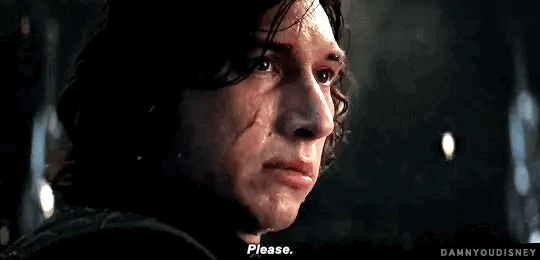
9. Phyllis Nefler (Troop Beverly Hills)
The definition of an icon. Khaki wishes and cookie dreams. Whomst I aspire to be when I find the right sugar daddy. What a thrill.
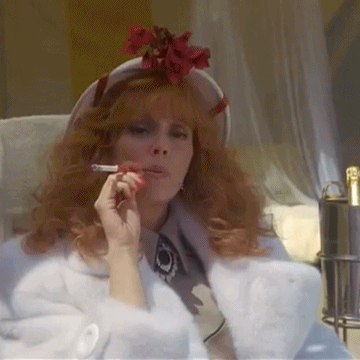
10. Clyde Logan (Logan Lucky)
The biggest softest boy. So big. So wide. Deserves the world. A fellow Southerner. World's best brother. Pregnancy is one of my squicks and I'd still let him knock me up.

Tagging people I follow and would like to know more about. @iolanthereylo @0biwan @hagenshall @jewishbensolo @notbythehairofmyfinnyfinnfinn
No pressure!
#about me#top ten characters#lady oscar#rose of versailles#utena#utena tenjou#sailor moon#elvira#beatrix kiddo#data#chirrut imwe#ben solo#phyllis nefler#clyde logan
16 notes
·
View notes
Text
hoorah, I finished the final book from the 41-50 range so I’m posting two of these today. here are some thoughts on books 41-50, as I continue to read along with the overdue podcast.
1. The Color Purple by Alice Walker
2. Winnie the Pooh by A.A. Milne
3. You Shall Know Our Velocity! by Dave Eggers
4. The Importance of Being Earnest by Oscar Wilde
5. The Martian Chronicles by Ray Bradbury
6. The Crucible by Arthur Miller
7. All Quiet on the Western Front by Erich Maria Remarque
8. A Christmas Carol by Charles Dickens -- In terms of pure enjoyment, this would have ranked higher, but I've been shamed into putting it slightly lower. It's a morally simplistic, rushed, psychologically unrealistic story but dammit I do not care! I loved this. It's genuinely so funny, I laughed throughout. Also, I love a redemption arc, and this is one of THE ultimate redemption stories. I think one of the themes I'm noting while pursuing this reading project is that I'm embracing happy endings big-time. Also, love the anti-capitalist themes. It's insane how people are still throwing around "overpopulation" in classist arguments when Dickens already murdered that argument back in 1840-something.
9. Winter's Bone by Daniel Woodrell -- Oh, the aesthetic, though! This made me want to dive into Ozark noir in a big way. I loved Ree Dolly, she's very much My Type of female character, I love scrappy women surviving poverty and being a lil butch about it and cramming an assload of determinator vibes into a tiny package. Her unreservedly affectionate friendship with Gail made me smile many times. The language was compelling without being distracting; a random favourite quirk is how it uses adjectives & verbs as nouns in reference to environmental features, e.g. referring to (I believe) melting snow as "melt". The brutality of it was great, it tread a very fine line for me where brutality against a female character can very easily veer into misogynistic and far too difficult to witness, but in this story the way it was depicted (combined with the fact that Ree is brutalized by women, not men) made it empowering to see her live through something horrific and survive. The gruesome details of, e.g. the fact that she shit herself while being beaten, and the tactile sensations when she was pulling [spoiler] up through the water, and the hunting of squirrels, that got me all snips-n-snails-n-puppy-dog-tails enthusiastic.
10. Middlesex by Jeffrey Eugenides
11. Metamorphosis by Franz Kafka
12. The Hound of the Baskervilles by Sir Arthur Conan Doyle
13. Life of Pi by Yann Martel
14. Flowers for Algernon by Daniel Keyes
15. The Picture of Dorian Gray by Oscar Wilde
16. A Lesson Before Dying by Ernest J Gaines
17. The Turn of the Screw by Henry James
18. Dracula by Bram Stoker -- It's been months since I read this book (I forgot to write down my impressions at the time) but I think I can still properly attest to my opinion of it. I was expecting a much simpler story, and I was expecting it to be more laden with cliches, which would not have been the book's fault at all since it would have been the birthplace of all those cliches, but it would have been boring to read. Instead, Dracula ended up being a totally solid read, and it's given me a thorough understanding of what makes it iconic gothic literature. It does kinda feel like multiple books smushed together, in particular the first section at Dracula's castle feels so separate from everything else (and, I will say, it was my favourite part of the book... always a bummer when enjoyment peaks early). I really liked the two female leads and their friendship, though I'm not a fan of what happens to Lucy and how little it seems to affect her best friend. Anyway, solid read, spooky in a lovely familiar way, I liked it and I get why it's beloved.
19. The Old Man and the Sea by Ernest Hemingway -- This was an oddly comfy book to read, for me, which might not have been what was intended but that's OK. It's very short and light on plot and you can definitely see all the conflict coming -- like, if you're not going to bring the fish on board, and you're in the ocean, of course shark are going to show up? I don't fish but is that not something you have to account for regularly? I enjoyed all his reflections on DiMaggio and his bone spurs, and the wistful, one-sided communication between him and the fish he regrets pursuing even as the pursuit continues. Also, the relationship between the old man and the boy is really heartwarming, and I love that the town he lives in is ultimately so supportive, I don't know why but I assumed that they would treat the old man poorly. Reminded me of all the most grounded bits of Life of Pi, in a good way.
20. A Visit From the Goon Squad by Jennifer Egan
21. Love in the Time of Cholera by Gabriel Garcia Marquez
22. World War Z by Max Brooks
23. Cat's Cradle by Kurt Vonnegut -- So, I'm very annoyed with myself about this one, because I forgot that I had not written up a blurb about Cat's Cradle until months after I finished it, and so much as happened since then (I finished it in 2019, at time of writing we are over two months into the 2020 covid-19 pandemic) that I legitimately had to google Cat's Cradle to remind myself what the plot was. So I definitely am not going to remember minutiae that impacted my opinion one way or the other. I remember it feeling very surreal, and the post-apocalyptic ending is very sudden. It has a lot of novel ideas and some approaches to philosophy that make me feel a bit too young (or just the wrong generation, more accurately) to really Get It. It was certainly novel, though, and passably fun. I'm so annoyed 'cause I'm sure I had Thoughts at the time but they're just gone.
24. Eddie and the Cruisers by P.F. Kluge
25. The Elements of Style by William Strunk Jr & E.B. White
26. The Strange Case of Dr. Jekyll and Mr. Hyde by Robert Louis Stevenson
27. No Exit by Jean-Paul Sartre
28. Pygmalion by George Bernard Shaw -- I love a story about class conflict, with a URL like “vimesbootstheory” how could it be otherwise. This did not gel with me as much as it should, though, simply because it took too long for me to figure out what the play was trying to say, essentially whether it was condemning Eliza or Higgins. Probably due to its many adaptations, I had been expecting Eliza and Higgins to get together in the end, so I was very arresteddevelopmentgoodforher.jpg about the actual conclusion to the story. That bit at the very end where Higgins is all, nah I heard what she said but she’s totally going to do my chores anyway, she’s just putting on a front... blegh. Fuck Higgins, fuck everything about that character, and fuck him for making phonetics look bad. That’s another thing, ooh. When I first started reading this I was anticipating much more time spent on the process of teaching Eliza how to “speak properly”. I was under the mistaken impression that “the rain in Spain falls mainly on the plain” was from Pygmalion, rather than My Fair Lady. And not gonna lie, I was a little excited to see this kind of proto-speech language pathology (though not pathological, since there is nothing pathologically wrong with having an accent suggestive of a lower class background) process play out in play form. Hell, I’d have taken any form of actual phonetics discussion. I was pretty disappointed when that whole process was completely skipped over, to be honest. Felt like a cop-out.
29. Battle Royale by Koushun Takami
30. The Raven by Edgar Allan Poe -- Let's be honest, it's weird that this is even on this list. Why not a collected works of Poe's poems, or a selection of his stories? No? Just the one poem? Uh, OK. Look, it's a good poem. Love the metre, love the rhyming. Love the idea of this guy who knows perfectly well that the bird only ever says "nevermore" but he keeps asking it questions to which "nevermore" is a hurtful and/or infuriating answer. That's all I got.
31. Mary Poppins by P.L. Travers -- I group this one together in my head with The Wonderful Wizard of Oz, as they are both children's books that were adapted by superior films and honestly, if you have a choice between the movie and the book, I would recommend the movie. This is also spoiled a bit by Travers' legacy of being a grumpy guss, even though her enemy was Disney and we're all learning these days that "ugh fuck Disney" is a valid take. Mary Poppins is better than Oz in that it has more book-exclusive content so there's more novelty to it than just reading a novelization of the movie, but worse in that Poppins, like her creator, is a grumpy guss. Her vanity was also really irritating to read about, like why do we have to condemn women for liking their own appearance?
32. Dune by Frank Herbert
33. The Wonderful Wizard of Oz by L Frank Baum
34. Tiny Alice by Edward Albee
35. Of Mice and Men by John Steinbeck
36. Medea by Euripides
37. Antony and Cleopatra by William Shakespeare
38. Frankenstein by Mary Shelley
39. The War of The Worlds by HG Wells
40. Don't Go Back to School by Kio Stark
41. The Awakening by Kate Chopin -- I compared this to Persuasion while reading it, since it's another old-timey romance where not a lot happens and the prose is pretty boring. Edna is more likeable than Anne, however, and the lengths she goes to claim the sort of agency that I take for granted every day is a pleasant surprise at times. Love that she had the balls to just fuckin move out and she doesn't suffer any violence from her husband as a result. Love how she's just like, I'm discovering independence and the first thing I wanna do is stay up past my bed time in this hammock outside. It felt like Edna aspired to... my life, basically? Which was validating, in a way. But then she kills herself, and kind of undercuts that whole thing. Seriously, what an abrupt and weird ending, I actually looked up a plot summary afterwards because I was so thrown when I got to the end, that it was actually the end. Didn't entirely understand what had happened to Robert, or that she had committed suicide until I clarified it with some external sources. By that point I was pretty bored, though, so that's partly just me letting details escape me through inattention.
42. Franny and Zooey by J.D. Salinger
43. The Unnamable by Samuel Beckett
44. The Stand by Stephen King
45. Grendel by John Gardner
46. Breakfast of Champions by Kurt Vonnegut
47. Persuasion by Jane Austen
48. Beowulf by Unknown
49. The Da Vinci Code by Dan Brown
50. Fifty Shades of Grey by EL James -- I was not looking forward to writing this little reaction blurb because once I got over my reader's block about 1/6th of the way in, reading fifty shades wasn't the worst reading experience? Like don't get me wrong, it was bad, but it was bad in an entertaining way. And I don't think it's accurate to say that I didn't have any interest in knowing what was going to happen next? So I was pretty worried that the dread fifty shades would end up embarrassingly high up this list, at least higher than The Stand (the other contender for Book It Took Me The Longest To Read Because Anger). Thankfully, in these little blurbs I've taken care to note things I found valuable about even the books I did not care much for, and nope, Fifty Shades really does belong at the bottom. I think its most grievous overarching issue is the gap between author intent and what's actually on the page. If this were actually a narrative about a sheltered young woman escaping a relationship with an abuser who confuses abuse with an interest in BDSM, that would accomplish partial forgiveness. But it isn't, so it doesn't. I've already mentioned this in another post but I can't get over this -- why does Anastasia not know anything about technology in the 2010s? Why did she wait so long to get a computer and an email address? Also, if I never read the phrasing "all [noun] and [noun]" as a descriptor again it will be too soon.
#charles dickens#daniel woodrell#dracula#earnest hemingway#kurt vonnegut#pygmalion#edgar allen poe#erin reads overdue books#mary poppins#fifty shades of grey#kate chopin#a christmas carol#winter's bone#bram stoker#the old man and the sea#cat's cradle#george bernard shaw#the raven#pl travers#el james#the awakening
0 notes
Text
I watched (only?) three movies yesterday and today during the Great Hurricane Irma Scare of 2017 and here are some super brief thoughts. We miraculously didn’t lose power once.
Butch Cassidy and the Sundance Kid (dir. George Roy Hill) - 1969 - US
What's better than this? Guys bein' dudes.
Redford and Newman are on such a special level of bromance in this and it's actually really wonderful to watch. Their chemistry is terrific, even if both have been much, much better than they are here. The rest of the cast, probably inevitably, is pretty much useless (poor Katharine Ross), but production value--the art direction, the costumes, the weirdly anachronistic music, and especially the gorgeous Oscar-winning cinematography--is more than up for the task. I wish the script didn't seem to meander as much as it does--I got much more bored than I expected--but on the whole, this is a super good time.
I should also mention, though, that this has absolutely nothing on The Sting. Thank goodness that was the Redford-Newman-Hill collab that actually won a bunch of Oscars and not this.
B+
Disraeli (dir. Alfred E. Green) - 1929 - US
Whoo lord. Here we see the predecessor to all the basic biopic Oscarbait. When Gary Oldman inevitably wins Best Actor for playing Churchill in Darkest Hour we can look at this as its ancestor.
Disraeli offers virtually nothing to a modern audience, save for the curio of an early-ass talkie and for George Arliss' Oscar-winning performance. He won the third Best Actor Oscar ever for his work here--apparently he played the role on at least three different occasions BEFORE filming this, so clearly this was something of a flagship role for him--and his work isn't bad. It reeks of early talkie dramatics, but he has some fine moments of strength and humor. It's pretty amazing though that as a film, Disraeli has aged so, so much worse than the films that won Best Actor just the next couple of years--the surprisingly potent pre-Code A Free Soul, the thrilling Dr. Jekyll and Mr. Hyde, the enjoyable The Private Life of Henry VIII, the enigmatic and beautiful The Informer, the masterpiece It Happened One Night, and even the schlocky The Champ (to an extent). Granted, film made leaps and bounds over the next several years, but Disraeli has very firmly been left behind, and pretty rightfully so.
C-
The Way We Were (dir. Sydney Pollack) - 1973 - US
Well that was a nice melodrama. There's that one really steamy sex scene that gets cut off so early it might as well be foreplay. The music is lovely, with Hamlisch's iconic love theme playing over every scene (what a year he had, between this and The Sting). Redford and Streisand make for a handsome couple (what a year HE had as well), even if Redford doesn't get to do much but passively react. Streisand, however, is actually really solid! She seems to nail pretty much everything in the arc of the role in a more complete way than I've seen of her. It's not an all-time great performance, but it's a really solid one.
As a political commentary, it's pretty toothless and is proof that Arthur Laurents' work on film was, uh, troubled.
B-
#sometimes elliott watches movies#butch cassidy and the sundance kid#george roy hill#the way we were#sydney pollack#disraeli#alfred e. green#george arliss#barbra streisand#robert redford#paul newman
3 notes
·
View notes
Text
Figuring It Out: The Films of Laura Dern
Jennifer Fox (Laura Dern) speaks in voiceover in a half-dazed, half-searching tone, as if slowly bringing herself out of a dream. “The story you are about to see is true … as far as I know.” A documentary filmmaker, she’s used to finding ways to look beyond the surface of what people present about themselves; she’ll have to turn that ability on herself. She remembers herself being and looking older than she was, speaking about a man she calls a lover—despite the fact that he was an adult and she was only 13—with a defensive, forced attempt at nonchalance (raised arms, dismissive pitch) that turns pleading, then incensed when she’s called a “victim,” her voice breaking into a raised whisper, her expression into a furious grimace. “This was important to me, and I’m trying to figure out why … Let me just figure this out for myself.”
“The Tale,” debuting on HBO on May 26, is documentary filmmaker Jennifer Fox’s narrative retelling of her experience, and an emotionally searing look at how people process their abuse. The casting of Dern, one of the most adventurous actresses working today, feels apropos, given the performer’s willingness to walk a constant emotional high-wire act and her recent hot streak that includes, but is not limited to, “Enlightened,” “Wild,” “Big Little Lies,” the “Twin Peaks” revival, and “Star Wars: The Last Jedi.” It’s also an instructive text when looking at Dern’s body of work, a career filled with stories of women who have either experienced or witnessed unbearable trauma and who are trying to find the meaning behind it all.
The daughter of two of New Hollywood’s greatest character actors (Bruce Dern and Diane Ladd), Laura Dern began her career in uncredited roles alongside her mother (“White Lightning,” “Alice Doesn’t Live Here Anymore”) before emancipating herself at 13 when her mother objected to one of her early credited roles in the teenage punk girl drama “Ladies and Gentlemen, The Fabulous Stains.” Dern’s role as one of the members of the Stains is relatively small (it’s largely Diane Lane’s show), but she makes an impression as being kind and empathetic, expressing genuine sympathy when a band member of another touring group overdoses. Dern’s teenage roles draw on her natural warmth and luminous presence; her performance as the blind Diana in “Mask” in particular sees her displaying an unusual level of openness with Eric Stoltz’s Rocky (born with a rare skull deformity), a willingness to accept him for who he is and stray outside her comfort zone for someone who accepts her.
Straying outside one’s comfort zone is central to Joyce Chopra’s “Smooth Talk” (pictured above), which gave Dern her breakout role as Connie Wyatt, a teenage girl hitting her rebellious years and having a hard time of it with her demanding mother. The first half of the film is a remarkable study of a teenager’s tentative first steps toward sexual exploration, with Dern veering back and forth between being marvelously unaffected (tossed-off delivery and leaning posture around her parents) and exaggerated flirtation, like that of someone who’s both fascinated bt sex and stuck in a childish, mocking view of it. She adopts confidence only to shrink away, puts her full body into a kiss before breaking off, admitting that she’s not used to “feeling … this excited.”
It’s in the second half, when a greaser (Treat Williams) appears outside when she’s home alone that “Smooth Talk” dives headfirst into that discomfort. Dern’s bashful body language gives way to a menacing, dancelike semi-seduction with Williams, shifting from apparent fun and games to something that’s outright predatory, with her demeanor collapsing collapse into hyperventilative terror. She’s in that uncertain place in between childhood and adulthood, when everyone is trying to define themselves, but there are plenty of men who have their own ideas of who she is and what they want from her. “Smooth Talk” would be an ideal (if grueling) double feature with “The Tale,” a young person’s immediate experience with sexual desire, confusion and abuse paired with an adult’s retrospective understanding of that trauma.
Dern received raves for her work, getting her first of two straight Independent Spirit Award nominations (back when they tried to be more than Oscar predictors); her next would come with a part that would bring her to greatest and most important collaborator. Few directors have brought as much out of Dern as David Lynch, but then, few performers have brought as much out of his characters as Dern, beginning with her role as Sandy in “Blue Velvet.” The archetypical girl next door, Sandy has a kind of unearthly wholesomeness that’s best showcased in her monologue about her dream about “robins of love.” The key to Lynch’s work is his belief that the truly good can coexist with the truly wicked. Dern represents the former, delivering the monologue with a whispered awe and reaching hand gestures that border on evangelical before bringing herself down and finding a way to clarify it to her rapt listener/love interest. Sandy and Jeffrey (Kyle MacLachlan) see some terrible things (including a painful moment of trauma that prompts a distorted look of sorrow that’s distinctly Dern), but she remains unwavering in her belief that her dream of light can conquer darkness and make sense of this strange world (would that Isabella Rossellini’s Dorothy were so lucky).
Dern teamed with Lynch again for 1990’s “Wild at Heart” (pictured above), playing the far more confidently sensual Lula while retaining the same good-heartedness she brought to “Blue Velvet.” It’s a heightened, deliberately iconic role, with Dern leaping into exaggerated dancing, purring with sexual abandon and leaning just so to express her arousal or satisfaction when talking to or about Nicolas Cage’s Elvis-obsessed Sailor. But Lula is also someone who has experienced great pain—the death of her father, her molestation at the hands of his friend, the murderous rage of her mother (played, in a stroke of casting genius, by her real-life mother, Ladd)—and has come out the other end demonstrating a full-bodied, defiant belief in the all-conquering power of love. The film’s “Wizard of Oz” framing device sometimes comes across as a bit forced, but it’s also another example of how Dern’s characters often tell themselves stories to make sense of their lives and guide them from darkness to light.
Dern’s early adult roles often deal with characters exploring their sexuality at a time or place where that might put them in jeopardy; that’s certainly the case with Martha Coolidge’s “Rambling Rose,” in which her “borderline nymphomaniac” Rose comes to live with the Hillyer family (father Robert Duvall, mother Ladd and teenage son Lukas Haas) after unspecified trouble with men. Dern brings a blithe, bouncy exuberance and confidence to the role, waltzing down the street knowing that her walk can turn heads and her smile win hearts. But Dern also embodies Rose’s goodness, her sexual escapades being the actions of someone who has an intense and open need to be loved, and to be treated with the kindness that she shows the world but that the world hasn’t been good enough to show her. A scene between her and Duvall after she’s caught in bed with a man sees her not going so far as begging, but rather earnestly presenting herself with all cards on the table, an eyes-wide-open, forward-leaning acknowledgement that “I’m only a human girl person, and I ain’t always perfect.”
“Rambling Rose” earned Dern her first Oscar nomination and preceded two high-profile supporting roles in 1993. As criminologist Sally Gerber in Clint Eastwood’s beautiful “A Perfect World,” she illustrates the impossible situation that Butch (Kevin Costner) was put in as a troubled child with an abusive father, giving a full picture of his trauma and bringing us to empathize with how he became a criminal. As Ellie Sattler in Steven Spielberg’s “Jurassic Park,” Dern plays the warmer counterpart and partner to Sam Neill’s testier Alan Grant, exuding, intelligence, physical capability and a deeper concern for how easily the park can spiral out of control and the consequences that come with it (she also has the ability as an actress to practically unhinge her jaw in terror when things do go wrong). In a key character moment, she pleads empathetically for John Hammond (Richard Attenborough) to recognize how the people they love may get hurt. Both roles cast her as figures of empathy, finding ways to make sense of the reasons why people cause each other pain while trying to prevent it from happening again.
If “A Perfect World” sees Dern asking us to sympathize with a troubled person, Alexander Payne’s “Citizen Ruth” (pictured above) shows how far that should be extended. Make no mistake: Dern’s pregnant, inhalant-addicted Ruth Stoops is a first-class fuck-up. Dern dives headfirst into making her as gross and unlikable as possible, smearing her mouth with inhalant residue, manipulating the same people who are manipulating her (both sides of the abortion debate attempt to co-opt her case for their agenda), and shouting some truly filthy insults (“suck the shit outta my ass, you fucker!”) with gritted teeth and gusto. Yet the actress still finds something sympathetic in her, her downcast eyes and fidgeting fingers communicating her knowledge that she’s fucked up yet again and is about to be on the receiving end of some real hardship. Ruth may sputter with uncertainty when trying to voice the whys behind her right to choose, but Payne and Dern take her choice, and the pain behind what led her to it, seriously (besides, she said it loud and clear the first time).
Dern’s career slowed down in the late 1990s and early 2000s, something she attributed (more than plausibly) to her guest appearance on “Ellen” as a radiant, openly gay woman that causes Ellen DeGeneres’ character to come out herself. She got her first serious critical attention in years in John Curran’s “We Don’t Live Here Anymore” in 2004. The film, about a two couples (Dern and Mark Ruffalo, Naomi Watts and Peter Krause) whose lives are upended when Ruffalo and Watts begin an affair, is too drifting and one-note to draw much blood, but it comes to life whenever Dern’s enraged, emotionally rangy Terry takes focus. Dern adopts a hunched-over posture for her arguments with Ruffalo, her clenched chin jutting out slightly, to show a woman who’s well aware of how she’s being deceived and whose total dismissal to the role of child caretaker (something she does not take to naturally) looks like it’s almost literally weighing her down. Terry’s agonies in “We Don’t Live Here Anymore” are resolutely ordinary, compared with some of the other characters Dern has played, but they’re no less important to her.
Dern reteamed with David Lynch for the truly deranged “Inland Empire,” in which she plays the actress Nikki Grace, getting the comeback of a lifetime with the role of Susan Blue before her role starts bleeding over into her identity (or something … even more than usual with Lynch, describing what actually happens seems futile and beside-the-point). It’s a tour-de-force performance, alternatively put-upon, ferocious, frightened, and whatever one can call this terrifying face. She’s simultaneously the film’s emotional anchor and its constantly metamorphosing nucleus. “Inland Empire” is, at least partially, about the emotional wringer that performers can put themselves through for a role, and how easy it is to mix up one’s own emotions with their character’s. A monologue in which Nikki’s character (?) describes her trauma and her self-defense in a jaded tone that occasionally sparks into violence is later seen in a theater, the actress observing herself. She’s played a character who has lived through real terror, but we see that the actress herself is living in terror, both at home (her husband is deeply controlling and ambiguously threatening) and at work. Does the actress simply play the part, or is she drawn to roles that bring her to relive (and potentially make peace with) her nightmares?
“Inland Empire,” like most of Lynch’s works, does not put its or its characters’ purpose into words so bluntly; Dern’s next major role is a little more easily (and narrowly) defined, but not uninteresting. The 2008 TV movie “Recount” (pictured above) relives the national trauma of Bush v. Gore, the second-most nightmarish presidential election in recent memory. Largely focused on the tactics employed the official campaign teams of Vice President Al Gore (Kevin Spacey, Denis Leary, Ed Begley Jr.) and Governor George W. Bush (Tom Wilkinson, Bob Balaban), the film also takes time with Florida Secretary of State Katherine Harris (Dern) and her poorly disguised efforts to throw the election to Bush. Dern walks a fine line between humanity and cartoon with Harris, whom she portrays as a zealous, wide-eyed ideologue with exaggerated hair and makeup. But she finds the heart of Harris in her true-believer story about Queen Esther sacrificing herself for “the lovely Jewish people,” evangelizing as if her staking her career on Bush winning the election is for the good of the people. Her self-martyring tone is farcical, but it’s also indicative of how political partisans view their work as de facto for the good of the people and a tool to bring a country together after a moment of bitter division, rather than the actions of further division.
Many of Dern’s more recent film roles have been smaller, supporting parts, but a few have still been notable. In Paul Thomas Anderson’s “The Master,” she has that same true-believer tone as a rich woman who has taken to the new religion of Lancaster Dodd (Philip Seymour Hoffman). Her student’s passion for something that’s given her life meaning is palpable; so is her shocked pain at being rebuked for questioning how, exactly, it can switch teachings so cavalierly, her body practically crumpling at Dodd’s shout. She’s more unflagging in her optimism as Reese Witherspoon’s mother in “Wild” (her second Oscar-nominated performance). Dern comes across in only a handful of small scenes as a vivacious presence who nonetheless knows perfectly well that she’s lived through hell, smiling through memories of pain because it brought her the most important person in her life. She’s the witness to someone else’s pain in Kelly Reichardt’s masterful “Certain Women,” a lawyer to a man (Jared Harris) who got screwed over when accepting a piddling settlement after a workplace injury but who can no longer be helped because of it. One senses her lived-in frustration as he refuses to listen her (then listens to a male colleague who tells him the same thing), but her genuine empathy for a man who she’s effectively powerless to help is also clear. And as Admiral Holdo in “Star Wars: The Last Jedi,” she commands the screen with a steadfast, unwavering certainty that she’s doing the right thing—any assumption of her incompetence be damned—finally proving herself to be among the bravest and most self-sacrificing heroes in the series.
Still, most of Dern’s best recent work has been on television. The brilliant, unjustly canceled “Enlightened” sees Dern’s personality as embedded into the work as Mike White’s (indeed, the two are credited as co-creators). Amy Jellicoe is another of Dern’s troubled heroines trying to find meaning in their lives, following her nervous breakdown first with a genuine attempt to regain the respect of her colleagues, then by becoming a corporate whistleblower in a move that’s half genuine, half out of bitterness. Amy’s a mess, lashing out at people she (rightly or wrongly) believes have wronged her at one moment, then preaching with a sincere but totally oblivious sense of illumination in the next. What holds Dern’s performance together as Amy whips back and forth between manic highs and deadening lows is an ardent, indefatigable expression that it’s possible for her to do something important with her life and potentially make the world a better place, no matter how crazy that world thinks she is.
Dern returned to HBO in “Big Little Lies,” with her Renata Klein initially set up as an ostensible villain; Dern tears into the overbearing, bullying aspect of Renata, whether she’s stabbing the air with her hands like a maniac or giving a silent but icy glare, shouting her threats at the top of her lungs or whispering them with quiet menace. But there’s still a beating heart in her, a genuine desire to protect her daughter from pain (whether it’s violence at school or the more everyday hurt of someone skipping her birthday party), and the heartbreak in Dern’s voice when she voices her feeling of utter powerlessness (a control freak’s worst nightmare for minor issues, let alone real pain) is unmistakable. Much of the strength in “Big Little Lies” is its belief that flawed women can ultimately come together, forgive each other and help each other along; Dern’s performance is key to that.
And still, “Big Little Lies” had only the second-best Dern performance on television last year. There’s a nostalgic, near-breathless thrill in Dern’s first appearance as Special Agent Dale Cooper’s long-unseen secretary Diane on “Twin Peaks” (or “Twin Peaks: The Return”), an unmistakable callback to their close connection in “Blue Velvet.” Still, one couldn’t have predicted Dern’s delightfully cynical performance, all long drags on cigarettes and venom-spitting “fuck yous,” a far cry from the mostly upbeat Sandy. But even putting aside the eventual revelation about Diane’s nature, it makes sense after decades of disillusionment following a rape by the man she most trusted. That pain comes through in her reunion with Bad Cooper, her voice breaking, her breath quickening; it’s even clearer in her late-series breakdown, her shield of cynicism giving way to trauma flooding back. Even Diane’s return to normalcy is a pyrrhic and only temporary victory, with a sex scene with MacLachlan’s Good Cooper playing less like a triumph and more like a final, deeply sad shared moment between the two (which Dern somehow conveys largely with her back), one of the show’s many acknowledgements that trauma cannot be erased.
“The Tale,” then, is instead a look at how one lives with that trauma. Fox’s gradual shift to acknowledging something terrible happened is not an easy journey, nor is it a simple one. The film deals heavily with the tortured self-rationalizations and denials employed by both survivors and abusers, ones both sincerely believed and desperately clung to. The final scene is confrontational without being fully cathartic, Dern’s belated but volcanic outrage a moment of her taking her past back (a real triumph) without any illusion that she has expelled that very pain. If there’s something Dern’s best work shows, it’s there forever; one can only try to make sense of it.
from All Content https://ift.tt/2x1Au7m
0 notes